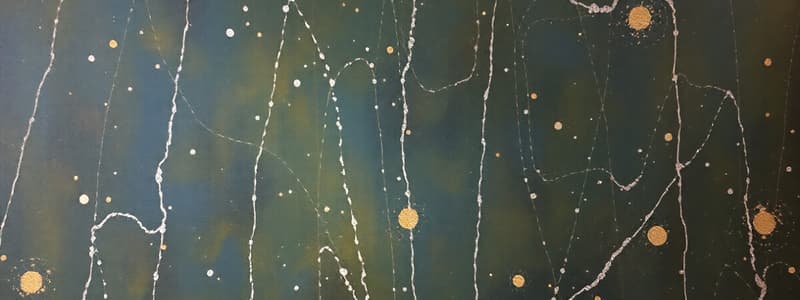Podcast
Questions and Answers
Which of the following is NOT a primary state of matter?
Which of the following is NOT a primary state of matter?
- Liquid
- Foam (correct)
- Solid
- Gas
Plasma has a definite shape and volume.
Plasma has a definite shape and volume.
False (B)
What type of matter is created at temperatures close to absolute zero?
What type of matter is created at temperatures close to absolute zero?
Bose-Einstein Condensate
The process of a solid changing directly to a gas is called _______.
The process of a solid changing directly to a gas is called _______.
Which characteristic is true for all gases?
Which characteristic is true for all gases?
Match the following phase changes with their definitions:
Match the following phase changes with their definitions:
The critical temperature is the temperature above which a substance can exist as a liquid.
The critical temperature is the temperature above which a substance can exist as a liquid.
What is the triple point in terms of states of matter?
What is the triple point in terms of states of matter?
Flashcards are hidden until you start studying
Study Notes
States of Matter
- Definition: States of matter are distinct forms that different phases of matter take on. The primary states are solid, liquid, gas, and plasma.
1. Solid
- Characteristics:
- Definite shape and volume
- Particles are closely packed in a fixed arrangement
- Strong forces between particles result in limited movement
- Types:
- Crystalline (regular arrangement, e.g., salt, diamonds)
- Amorphous (irregular arrangement, e.g., glass, plastic)
2. Liquid
- Characteristics:
- Definite volume but takes the shape of its container
- Particles are close together but can move past one another
- Moderate intermolecular forces allow for flow and compression
3. Gas
- Characteristics:
- Neither definite shape nor volume
- Particles are far apart and move freely
- Weak intermolecular forces, allowing for expansion and compression
- Behavior: Fills the entire volume of its container
4. Plasma
- Characteristics:
- Ionized gas with free-moving ions and electrons
- No definite shape or volume
- Conducts electricity and responds to magnetic fields
- Occurrence: Found in stars, including the sun, and fluorescent lights
5. Additional States
- Bose-Einstein Condensate:
- Formed at temperatures close to absolute zero
- Atoms occupy the same quantum state, behaving as a single quantum entity
- Fermionic Condensate:
- Similar to Bose-Einstein, but formed with fermions, pairs of fermions at low temperatures
6. Phase Changes
- Processes:
- Melting: Solid to liquid
- Freezing: Liquid to solid
- Vaporization: Liquid to gas
- Includes evaporation and boiling
- Condensation: Gas to liquid
- Sublimation: Solid to gas without becoming liquid
- Deposition: Gas to solid without becoming liquid
7. Critical Points
- Critical Temperature: The temperature above which a substance cannot exist as a liquid, regardless of pressure.
- Triple Point: The unique set of conditions where all three phases (solid, liquid, gas) can coexist in equilibrium.
Summary
Understanding the states of matter and their transitions is fundamental to chemistry and physics, influencing various natural phenomena and practical applications in industries such as materials science, engineering, and environmental technology.
States of Matter
- Definition: Matter exists in distinct forms called states of matter. The primary states are solid, liquid, gas, and plasma.
- Solid: Solids have definite shape and volume. Particles are tightly packed in a fixed arrangement with strong forces between them, limiting movement.
- Types of solids:
- Crystalline: Solids with a regular, repeating arrangement of particles, examples include salt and diamonds.
- Amorphous: Structures lacking a regular arrangement. Examples include glass and plastic.
- Types of solids:
- Liquid: Liquids have a definite volume but take the shape of their container. Particles are close together but can move past one another.
- Intermolecular forces: Moderate forces between particles allow liquids to flow and compress.
- Gas: Gases have neither a definite shape nor volume and fill the entire available space. Particles are far apart and move freely, with weak intermolecular forces.
- Expansion and Compression: The weak forces allow gases to expand and compress easily.
- Plasma: Plasma is a state of matter composed of ionized gas with free-moving ions and electrons. It has no definite shape or volume.
- Properties: Conducts electricity and responds to magnetic fields.
- Occurrence: Plasma is found in stars, such as the sun, and in fluorescent lights.
- Bose-Einstein Condensate: A state of matter formed by cooling atoms to near absolute zero (-273.15 °C or -459.67°F). In this state, atoms occupy the same quantum state acting like a single quantum entity.
- Fermionic Condensate: Similar to Bose-Einstein condensate but formed with fermions, which are particles with half-integer spins. Fermionic condensates are created by pairing up fermions at low temperatures.
- Phase Changes: Transitions between states of matter.
- Melting: Solid to liquid
- Freezing: Liquid to solid
- Vaporization: Liquid to gas
- Evaporation: Vaporization that occurs at the surface of a liquid
- Boiling: Vaporization that occurs throughout the liquid
- Condensation: Gas to liquid
- Sublimation: Solid to gas without becoming liquid.
- Deposition: Gas to solid without becoming liquid.
- Critical Point: The temperature and pressure above which a gas cannot be liquefied.
- Critical Temperature: The temperature above which a substance cannot exist as a liquid, regardless of pressure.
- Triple Point: The unique set of conditions where all three phases (solid, liquid, and gas) can coexist in equilibrium.
Summary
Understanding the states of matter, their properties, and their transitions is essential in many fields, including chemistry, physics, and materials science.
Studying That Suits You
Use AI to generate personalized quizzes and flashcards to suit your learning preferences.




